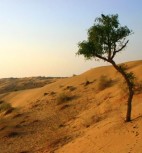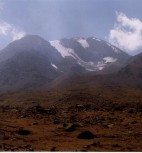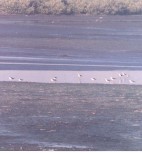According to a report from WWF, Pakistan has 225 Secured Places, 99 sanctuaries, 14 national parks, and 96 game reserves.
Northern highlands and plains
The northern highlands of the subcontinent are covered with scrub, pine and conifer and forests, which have been condensed to very little growth in most places. These lands not only include lesser elevation territories of Potohar and Azad Kashmir but also the higher elevation areas taking on the foothills of Himalayan, Karakorum and Hindukush mount ranges. This is a superb habitat for wildlife in the form of alpine graze lands, sub-alpine scrub and temperate jungle. Man is limited to the lower grounds and find survival in these wilderness hard, hence, wildlife is present in sound numbers here though some are endangered for other reasons.
According to the final reports of IUCN, a number of least threatened species of mammals find these highlands home. These include of Indian leopard, Himalayan goral, Bharal, Marmot, Eurasian lynx, Marco Polo sheep and yellow-throated marten.Species of Aves include Himalayan monal, Chukar partridge, Eurasian eagle-owl and the Himalayan Snowcock. Amphibian species of Himalayan toad and Muree Hills frog are abundant here as well. These high planes are also habitat of Endangered animal species incorporatin the Rare Snow Leopard, Himalayan brown bear, Kashmir gray langur, Asiatic black bear, Musk deer, Indian wolf, Kashmir red deer, Rhesus macaque, Siberian ibex, smooth-coated otter and the rare wild goats Markhor.
The Indus plains and Deserts of Sindh
 The Punjab plains are in the main irrigated by the Indus River and its tributaries i.e. Jhelum, Ravi, Chenab, Sutlej, and the Beas. These plains of river Indus prolong towards and occupy for the most part of western Sindh. Where there is water, there is life, so the plains are appealing to both humans and wildlife for agricultural goals and development of civilization. Immense of the Indus flood plains have been unoccupied of natural flora to grow crops. This has resulted in some species being endangered. A wide variety of species of aves is found her that include, bird species of Red-vented bulbul, Rock pigeon, Barn owl, Indian peafowl, Alexandrine parakeet, black kite, Myna, hoopoe, Shelduck and Shikra. Mammal species are also found in abundance here, The Nilgai, Pangolin, Punjab Urial, Blackbucks, Horseshoe Bat, Red fox and Wild boar are in a vast area but some mamal species have been graded threatened by the IUCN and include the Indian rhinoceros, hog deer, axis deer, blackbuck, Punjab urial and Sindh ibex.
The Punjab plains are in the main irrigated by the Indus River and its tributaries i.e. Jhelum, Ravi, Chenab, Sutlej, and the Beas. These plains of river Indus prolong towards and occupy for the most part of western Sindh. Where there is water, there is life, so the plains are appealing to both humans and wildlife for agricultural goals and development of civilization. Immense of the Indus flood plains have been unoccupied of natural flora to grow crops. This has resulted in some species being endangered. A wide variety of species of aves is found her that include, bird species of Red-vented bulbul, Rock pigeon, Barn owl, Indian peafowl, Alexandrine parakeet, black kite, Myna, hoopoe, Shelduck and Shikra. Mammal species are also found in abundance here, The Nilgai, Pangolin, Punjab Urial, Blackbucks, Horseshoe Bat, Red fox and Wild boar are in a vast area but some mamal species have been graded threatened by the IUCN and include the Indian rhinoceros, hog deer, axis deer, blackbuck, Punjab urial and Sindh ibex.
Sindh krait, Indian cobra, Indian star tortoise Russell’s Viper and yellow monitor are the major reptilians of these plains. Amphibian species comprise of and Indus Valley toads and bullfrog. bird species of white-backed vulture and reptile species of black pond turtle andgharial. Grey partridge is one of the few birds that can be found in the Cholistan desert. The Tharparkar desert supports a fair population of the chinkara. The Asiatic wild ass migrates from the Indian part of the Great Rann of Kutch to the part in Pakistan in search of food. Wild boar numbers have increased because of the immunity they enjoy in a Muslim society that forbids its consumption by humans.
Western highlands, plains and deserts
 Mountainous area forms Western Highlands of Pakistan and it is extended in the south from the Makran Coast in the to the Pamir Plateau in the farthest north. Western expanse of Pakistan has a complex geography, most of which is enveloped in the Baluchistan province. In mountainous highlands, habitat varies from conifer forests of deodar in Waziristan andjuniper in Ziarat. Numerous mountain ranges surround the huge lowland plains of Baluchistan Plateau, through which a rather intricate meshwork of seasonal rivers and salt pans is spread. Deserts are also present, showing xeric shrubland vegetation in the region. Date palms and ephedra are common flora varieties in the desert. Some of the mammal species include the caracal, Baluchistan dormouse, Blanford’s fox, dromedary camel, Goitered gazelle, Indian crested porcupine, Long-eared hedgehog, markhor, ratel and striped hyena, bird species of bearded vulture, Houbara bustard and Merlin, reptile species of leopard gecko and saw-scaled viper and amphibian species of Baluchistan toad.
Mountainous area forms Western Highlands of Pakistan and it is extended in the south from the Makran Coast in the to the Pamir Plateau in the farthest north. Western expanse of Pakistan has a complex geography, most of which is enveloped in the Baluchistan province. In mountainous highlands, habitat varies from conifer forests of deodar in Waziristan andjuniper in Ziarat. Numerous mountain ranges surround the huge lowland plains of Baluchistan Plateau, through which a rather intricate meshwork of seasonal rivers and salt pans is spread. Deserts are also present, showing xeric shrubland vegetation in the region. Date palms and ephedra are common flora varieties in the desert. Some of the mammal species include the caracal, Baluchistan dormouse, Blanford’s fox, dromedary camel, Goitered gazelle, Indian crested porcupine, Long-eared hedgehog, markhor, ratel and striped hyena, bird species of bearded vulture, Houbara bustard and Merlin, reptile species of leopard gecko and saw-scaled viper and amphibian species of Baluchistan toad.
Coastal regions, Wetlands, and marine life
 The coastline of Pakistan is 1,050 km long and consists of a variety of habitat types, supporting a wide range of animals, of which over 1000 are fish species in the reefs of its continental shelf. The east half of the coast of Pakistan is located in the south of Sindh province which features Indus River Delta and coast of Great Rann of Kutch. The largest saltwater wetland in Pakistan is the Indus River Delta. Unlike many other river deltas, it consists of clay soil and is very swampy. West coast of Great Rann of Kutch, east to the Indus River Delta and below Tharparkar desert, is one of the few places where greater flamingos come to breed. It is also a habitat for endangered species of lesser florican. Unlike Indus River Delta, this part of the coast is not as swampy and exhibits shrubland vegetation of rather dry thorny shrubs as well as marsh grasses of Apluda and Cenchrus.
The coastline of Pakistan is 1,050 km long and consists of a variety of habitat types, supporting a wide range of animals, of which over 1000 are fish species in the reefs of its continental shelf. The east half of the coast of Pakistan is located in the south of Sindh province which features Indus River Delta and coast of Great Rann of Kutch. The largest saltwater wetland in Pakistan is the Indus River Delta. Unlike many other river deltas, it consists of clay soil and is very swampy. West coast of Great Rann of Kutch, east to the Indus River Delta and below Tharparkar desert, is one of the few places where greater flamingos come to breed. It is also a habitat for endangered species of lesser florican. Unlike Indus River Delta, this part of the coast is not as swampy and exhibits shrubland vegetation of rather dry thorny shrubs as well as marsh grasses of Apluda and Cenchrus.
There are a number of protected wetlands (under Ramsar Convention) in Pakistan. These include Tanda dam and Thanedar Wala in Khyber Pakhtunkhwa, Chashma barrage, Taunsa barrage and Uchhali complex in Punjab, Haleji lake, Hub dam and Kinjhar lake in Sindh, Miani Hor in Balochistan. The wetlands are an habitat for migratory birds such as dalmatian pelicans and demoiselle craneas well as predatory species of osprey, common kingfisher, fishing cat and leopard cat near the coast line. Chashma and Taunsa Barrage Dolphin Sanctuary protects the threatened species of Indus River dolphins which tend to live in freshwater.
The west half of the Pakistan coast is in the south of Balochistan province. It is also called the Makran coast and exhibits protected sites such as Astola Island and Hingol National Park. The three major mangrove plantations of Balochistan coast are Miani Hor, Kalmat Khor and Gwatar Bay. Miani Hor is a swampy lagoon on the coast in the Lasbela district where the climate is very arid. The sources of fresh water for Miani Hor are the seasonal river of Porali. The nearest river to the other lagoon, Kalmat Khor, is the Basol River. Gawatar, the third site, is an open bay with a mouth almost as wide as its length. Its freshwater source is the Dasht River, the largest seasonal river of Baluchistan. All three bays support mainly A. marina species of mangrove. Pakistan also plans to rehabilitate mangrove-degraded areas at Sonmiani and Jiwani in Balochistan.
The vegetation of Indus River Delta is mainly represented by various mangrove species and bamboo species. The Indus River Delta-Arabian Sea mangroves is a focused ecoregion of WWF. Nearly 95% of the mangroves located in the Indus River Delta are of the species Avicennia marina. Very small patches of Ceriops roxburghiana and Aegicerias corniculata are found. These provide nesting grounds for common snakehead, giant snakehead, Indus baril and many species of catfish like rita. The hilsa swims up from the Arabian Sea to spawn in freshwater. Numerous species are important to people as food, such as the golden Mahseer and large freshwater Shrimp (Macrobrachium species), are part of the abundant aquatic life.
Along the shores of Astola and Ormara beaches of Balochistan and Hawk’e Bay and Sandspit beaches of Sindh are nesting sites for five endangered species of sea turtles: Green Sea, Loggerhead, Hawksbill, Olive Ridley and Leatherback. Sea snakes such as yellow-bellied sea snake are also found in the pelagic zone of the sea. The wetlands of Pakistan are also a home to the endangered species of Gharial and mugger crocodile who prefer freshwater habitat.

I love your blog.. very nice colors & theme. Did you design this website yourself or did you hire someone to do it for you? Plz answer back as I’m looking to design my own blog and would like to know where u got this from. thank you